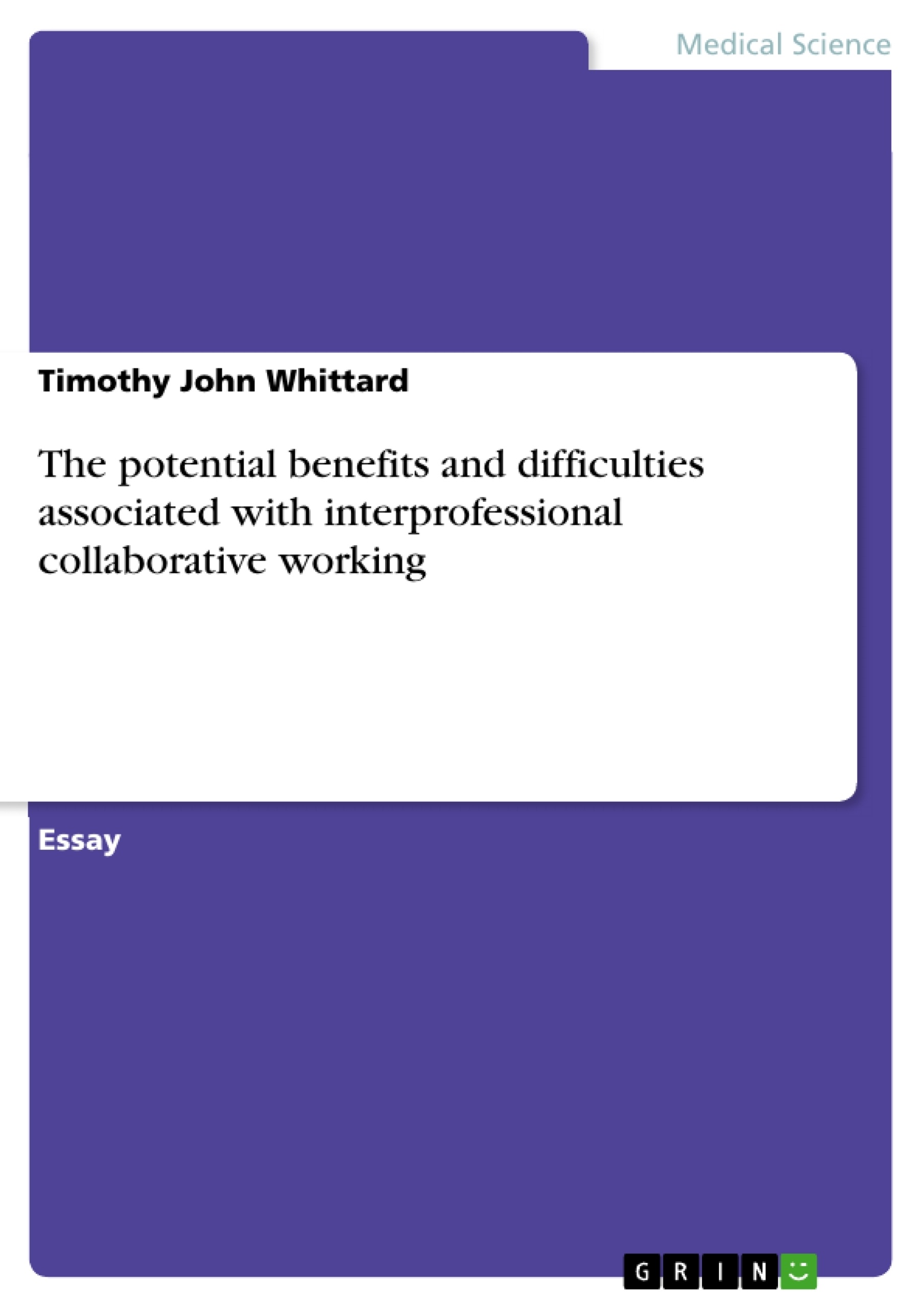This essay aims to explore different aspects of interprofessional collaboration across healthcare professions, and highlights the benefits and potential difficulties associated with interprofessional working. These topics were discussed extensively within my interprofessional group, and were investigated through enquiry-based learning.
Table of Contents
- Introduction
- Benefits of Interprofessional Collaboration
- Difficulties in Interprofessional Collaboration
Objectives and Key Themes
This essay explores the benefits and challenges of interprofessional collaboration in healthcare, drawing on experiences from a module's group work. It aims to analyze how such collaboration impacts both patient care and the professionals involved.
- Benefits of interprofessional collaboration for patient care
- Challenges to effective interprofessional collaboration
- The role of communication in interprofessional teams
- Impact of interprofessional collaboration on professional satisfaction
- The need for interprofessional education and training
Chapter Summaries
Introduction: This introductory section establishes the essay's aim to explore the advantages and disadvantages of interprofessional collaboration in healthcare. It defines interprofessional collaboration, provides a brief historical overview of its development within healthcare settings, and highlights its growing importance in delivering effective and holistic patient care. The author emphasizes the increasing demand for collaborative teamwork due to evolving health and social care policies and the complexity of modern patient needs. The essay lays the groundwork for a deeper analysis of the topic using the author's own experiences in an enquiry-based learning setting as a primary source of examples and evidence.
Benefits of Interprofessional Collaboration: This section details the numerous advantages of successful interprofessional collaboration, impacting both patients and healthcare professionals. It emphasizes the improved patient-centered care resulting from shared responsibility and the inclusion of patients and families in decision-making. Examples highlight increased job satisfaction, reduced work-related stress among professionals, and improved team bonding. The author uses a practical example from their own module's group exercise, illustrating how a collaborative task fostered camaraderie amongst previously unfamiliar students. This section demonstrates that effective interprofessional teamwork is essential for optimal healthcare delivery and good practice, supported by extensive citation of relevant literature.
Difficulties in Interprofessional Collaboration: This section addresses the significant challenges in implementing effective interprofessional collaboration. It identifies key inhibitory factors, such as poor communication, conflicting power relations, and role confusion, which can significantly hinder teamwork. The tragic case of Victoria Climbié is presented as a powerful example of the devastating consequences of poor communication and coordination among professionals. The section analyzes communication breakdowns as a major obstacle, emphasizing the critical need for clear and consistent information sharing. Other challenges discussed include variations in professional knowledge, terminology, and the ambiguity surrounding roles and responsibilities within interprofessional teams. The author uses the Victoria Climbié case to illustrate how a lack of understanding of each professional's role can lead to critical errors and omissions in care.
Keywords
Interprofessional collaboration, healthcare, teamwork, communication, patient-centered care, job satisfaction, role confusion, Victoria Climbié, enquiry-based learning, interprofessional education.
Frequently Asked Questions: A Comprehensive Language Preview
What is the purpose of this document?
This document provides a comprehensive preview of a language learning resource. It includes a table of contents, objectives and key themes, chapter summaries, and keywords. The content focuses on the benefits and challenges of interprofessional collaboration in healthcare.
What topics are covered in this resource?
The resource explores the benefits and challenges of interprofessional collaboration in healthcare. Specific topics include the impact of collaboration on patient care and professional satisfaction, the role of communication in interprofessional teams, and the need for interprofessional education and training. It also examines difficulties such as poor communication, conflicting power relations, and role confusion.
What are the key benefits of interprofessional collaboration highlighted in the document?
The document emphasizes improved patient-centered care, increased job satisfaction among professionals, reduced work-related stress, and improved team bonding as key benefits. It highlights how shared responsibility and the inclusion of patients and families in decision-making contribute to better outcomes.
What are the main challenges associated with interprofessional collaboration discussed?
The document identifies poor communication, conflicting power relations, role confusion, variations in professional knowledge and terminology, and ambiguity surrounding roles and responsibilities as significant challenges. The tragic case of Victoria Climbié is used to illustrate the devastating consequences of poor communication and coordination.
How is the Victoria Climbié case used in the resource?
The Victoria Climbié case serves as a powerful example of the devastating consequences of poor communication and coordination among healthcare professionals. It highlights how a lack of understanding of each professional's role can lead to critical errors and omissions in care.
What type of learning is mentioned in relation to the resource?
The document mentions "enquiry-based learning" as the primary source of examples and evidence used by the author in their analysis of interprofessional collaboration.
What keywords are associated with this resource?
Key words include: Interprofessional collaboration, healthcare, teamwork, communication, patient-centered care, job satisfaction, role confusion, Victoria Climbié, enquiry-based learning, interprofessional education.
What is the structure of the resource?
The resource is structured with an introduction, a section on the benefits of interprofessional collaboration, a section on the difficulties of interprofessional collaboration, and a conclusion (implied). Each section provides a summary of its key points.
Who is the intended audience for this resource?
While not explicitly stated, the intended audience appears to be academics or students studying healthcare, interprofessional collaboration, or related fields. The use of academic language and references suggests a focus on scholarly analysis.
Where can I find more information about this resource?
More information about the full resource would be needed to answer this question. This document is only a preview.
- Quote paper
- Timothy John Whittard (Author), 2005, The potential benefits and difficulties associated with interprofessional collaborative working, Munich, GRIN Verlag, https://www.grin.com/document/471344



